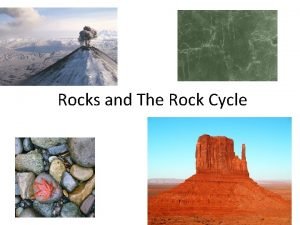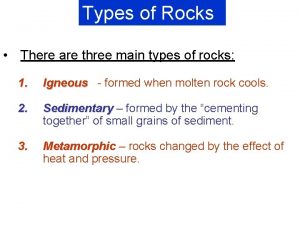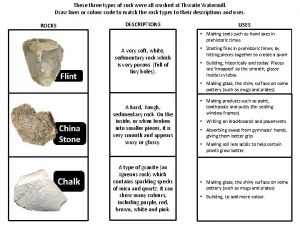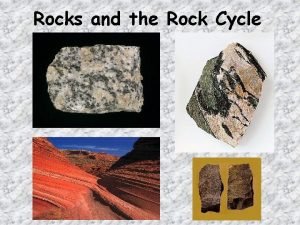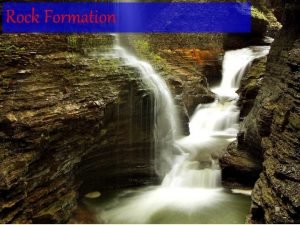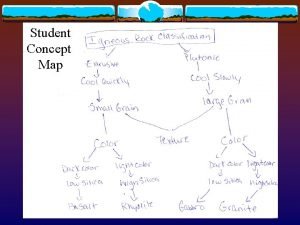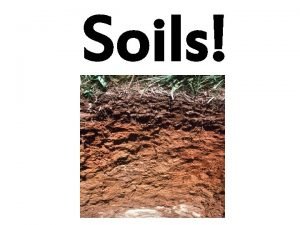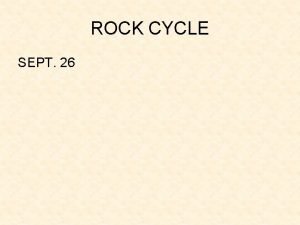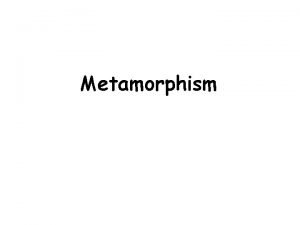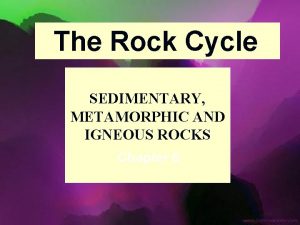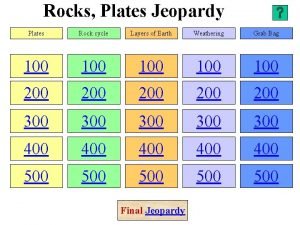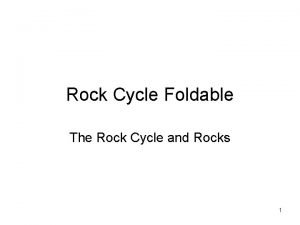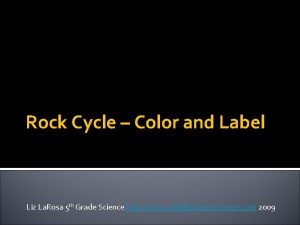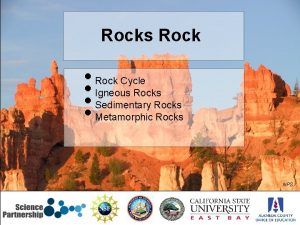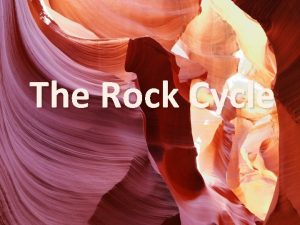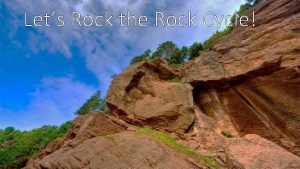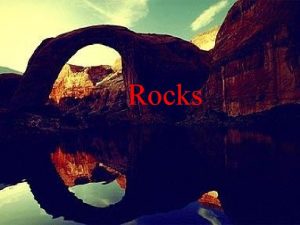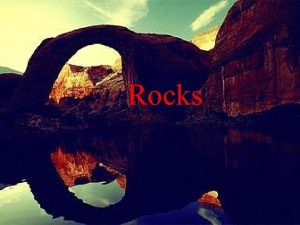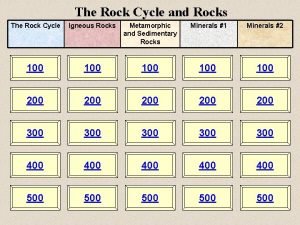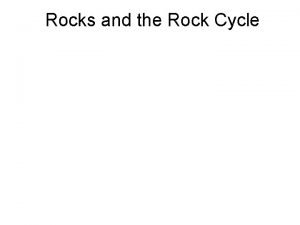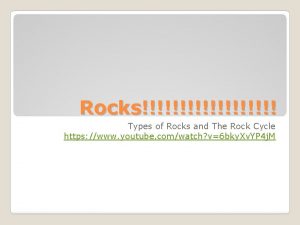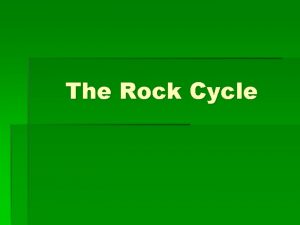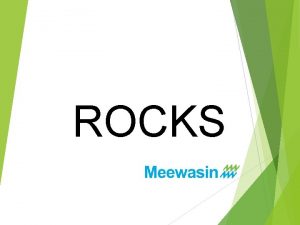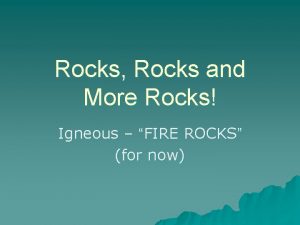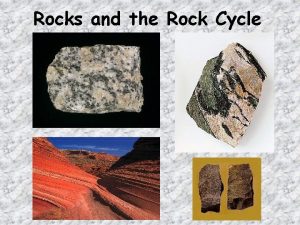Rocks and the Rock Cycle Three Types of


























- Slides: 26

Rocks and the Rock Cycle

Three Types of Rocks • Rocks are classified by how they form – Igneous – Sedimentary – Metamorphic – Rocks can change from one type to another over time Schist

Rock Classification • Rocks are classified by: – – How they form Texture Grain size Mineral composition Conglomerate Sedimentary Rock

Igneous Rocks • Igneous rock: forms when molten rock (magma) cools and hardens • Classified by: – Where they form – Crystal (grain) size Basalt

Intrusive Igneous Rock • Intrusive igneous: cooling takes place slowly beneath Earth’s surface granite

Extrusive Igneous Rock • Extrusive igneous: cooling takes place rapidly on Earth’s surface Pumice

Sedimentary Rock • Sedimentary rock: forms from the compaction and/or cementation of sediments • This process is called Limestone lithification • Sediments are: – Rock pieces – Mineral grains – Shell fragments

How do sediments form? weathering • Sediments form through the processes of weathering and erosion of rocks exposed at Earth’s surface erosion

Sedimentary Rock con’t…. • Sedimentary rock can also form from the chemical depositing of materials that were once dissolved in water • When water evaporates, minerals are left behind and form rock gypsum

Metamorphic Rock • Metamorphic rock: forms when any rock type is changed into a different kind of rock • Changes due to great heat and/or pressure Gneiss

How does rock change? • Rocks are heated, squeezed, folded, or chemically changed by contact with hot fluids marble

The Rock Cycle

The Earth Recycles Rock • The rock cycle is an ongoing series of processes inside Earth and on the surface • Slowly changes rocks from one kind to another • Any type of rock can change into another type

How does this relate to plate tectonics? • Plate movement drives the rock cycle – Subduction (1 plate pushed under another plate) • Re-melts rock into magma – Mountain building • Folding, faulting, uplift • Exposes rock at the surface to be weathered and eroded






a. Cementation and compaction (lithification) b. Heat and pressure c. Weathering, transportation(erosion), and deposition d. Cooling and solidification e. Melting

Rocks/Rock Cycle Foldable • Your foldable should include the following: 1. Name of each rock type 2. How each rock type formed 3. A brief description of rock type 4. At least 2 examples of each rock type 5. Illustrate 1 example for each rock type

Copy Me

Do Now – Tuesday March 11 In Textbook: • Complete • pg. 107 #1 -8

Do Now – Thursday March 4 Rock Texture Composition Comments Conglomer ate Coarse, 2 mm Rounded pebbles, sand clay can easily be seen Sandstone Medium, . 0625 – 2 mm Quartz, other minerals and rock fragments Sand grains can be seen; rough surfaces Shale Microscopic, . 004 -. 06 mm Clays, micas Has muddy appearance Limestone Coarse to fine Calcite, shells May contain fossils, seashells; fizzes when in hydrochloric acid Chert Fine Quartz Is light-colored; also called flint; once used for arrowheads Rock salt Coarse to fine Halite Has salty taste; table salt Limestone is composed of the mineral A. quartz B. calcite C. halite D. gypsum Based on the information given about each of these rocks, into which rock type would all these examples be classified? A. Igneous B. Metamorphic C. Sedimentary D. Mineral

Moh's Hardness Scale Approximate Hardness of Common Objects Talc 1 Gypsum 2 Fingernail (2. 5) Calcite 3 Copper penny (3. 5) Fluorite 4 Iron nail (4. 5) Apatite 5 Glass (5. 5) Feldspar 6 Steel file (6. 5) Quartz 7 Streak plate (7. 0) Topaz 8 Corundum 9 Gypsum Diamond 10 Which statement is best supported by the data shown? A. An iron nail contains fluorite. B. A streak plate is composed quartz. C. Topaz is harder than a steel file. D. Apatite is softer than a copper penny.

Based on the processes shown in the diagram, which type of rock is formed at #1? A. Sedimentary B. Igneous C. Metamorphic D. Clastic Because heat and pressure are needed to form #3, it must be what type of rock? A. Sedimentary B. Igneous C. Metamorphic D. Clastic
 Igneous metamorphic and sedimentary
Igneous metamorphic and sedimentary Igneous rocks metamorphic rocks and sedimentary rocks
Igneous rocks metamorphic rocks and sedimentary rocks Diagram of rock cycle for class 7
Diagram of rock cycle for class 7 How is intrusive igneous rock formed
How is intrusive igneous rock formed Andesite vs basalt
Andesite vs basalt Rock types and cycle quick check
Rock types and cycle quick check What are the three main types of rocks
What are the three main types of rocks Three types of rocks
Three types of rocks Which type of rock
Which type of rock Sedimentary rocks physical properties
Sedimentary rocks physical properties Chapter 3 standardized test practice answers
Chapter 3 standardized test practice answers A rock climber's shoe loosens a rock and her climbing buddy
A rock climber's shoe loosens a rock and her climbing buddy Igneous rock concept map
Igneous rock concept map Igneous rock concept map
Igneous rock concept map Rock cycle sedimentary
Rock cycle sedimentary Climbing rock climbing
Climbing rock climbing How does soil link the rock cycle and biosphere?
How does soil link the rock cycle and biosphere? Rock cycle explanation and diagram
Rock cycle explanation and diagram Contact metamorphism and regional metamorphism venn diagram
Contact metamorphism and regional metamorphism venn diagram Rock cycle comic strip
Rock cycle comic strip Rock cycle song for kids
Rock cycle song for kids Rock cycle learning objectives
Rock cycle learning objectives Rock cycle jeopardy
Rock cycle jeopardy Types of rocks song
Types of rocks song Rock cycle
Rock cycle Rock cycle foldable
Rock cycle foldable Rock cycle coloring
Rock cycle coloring





